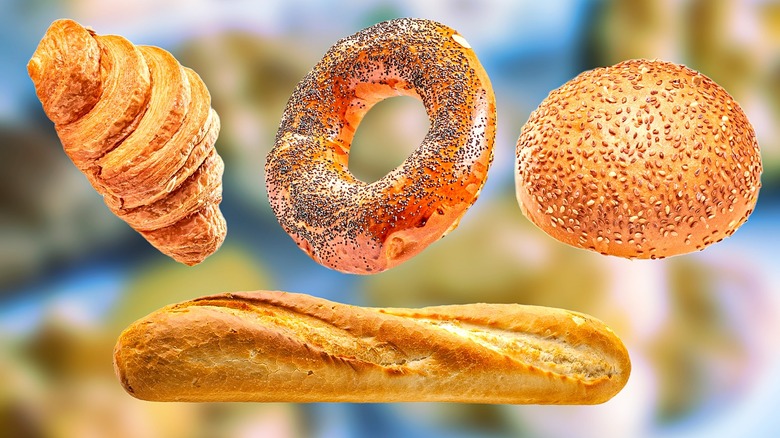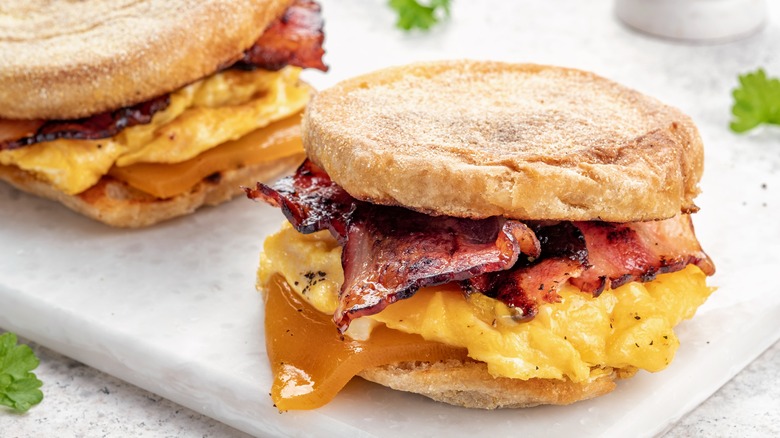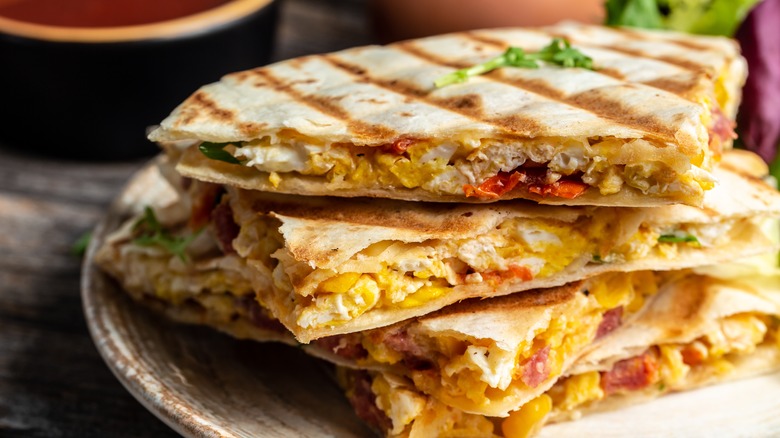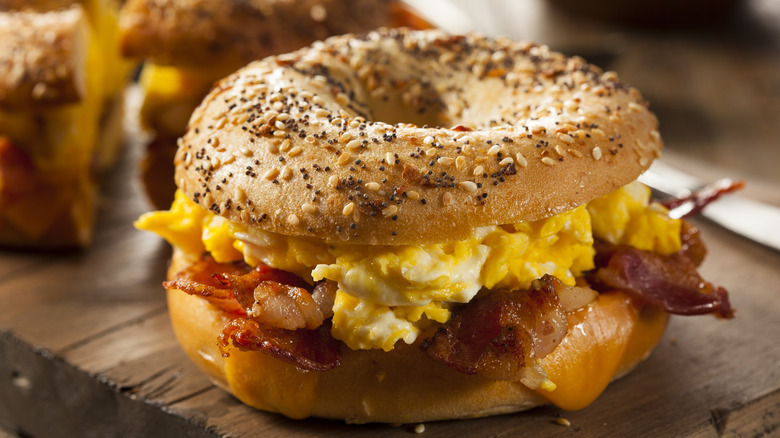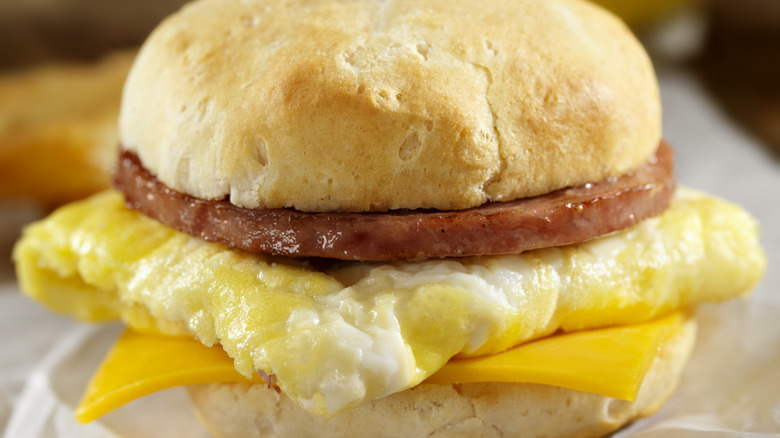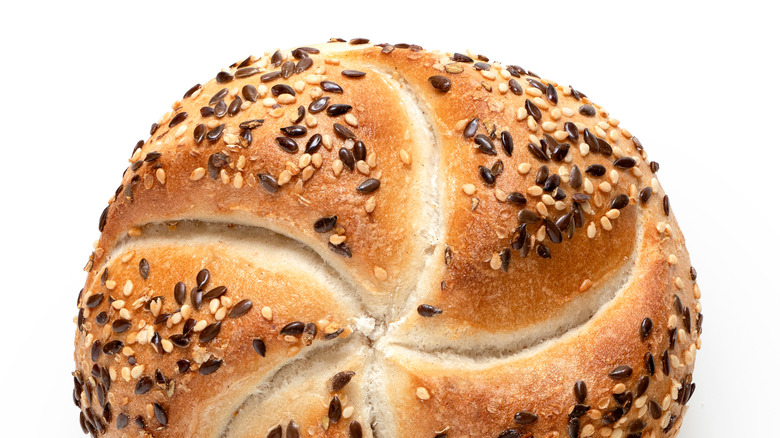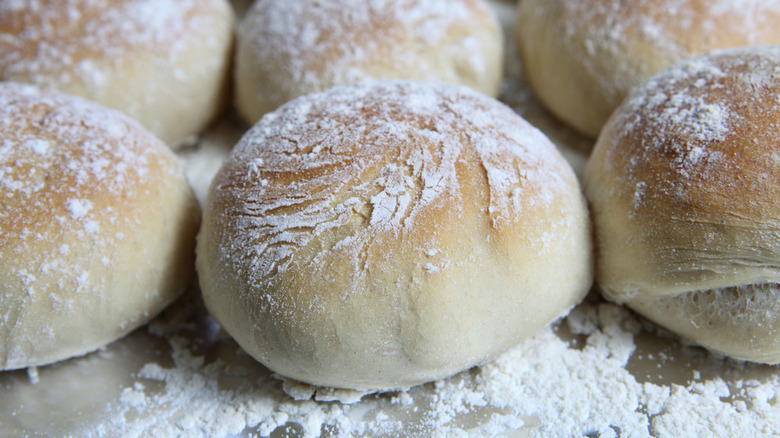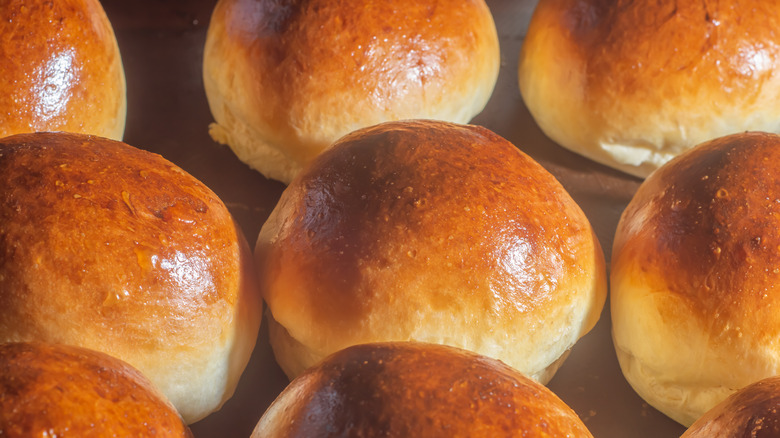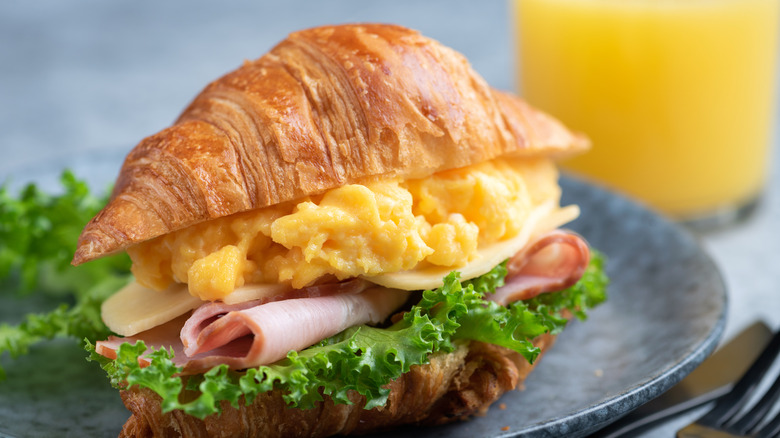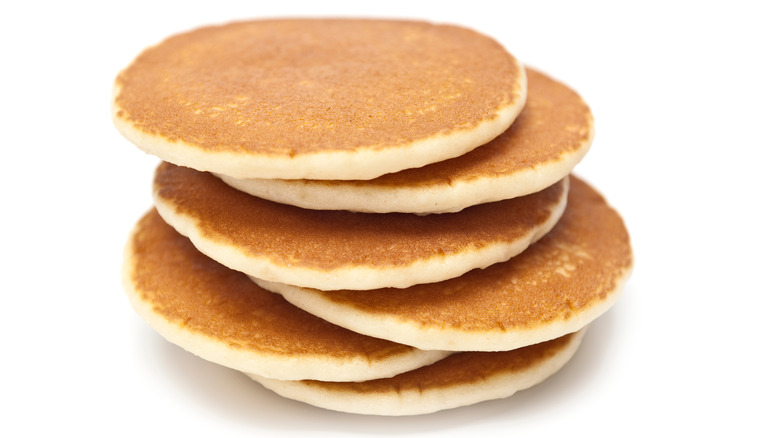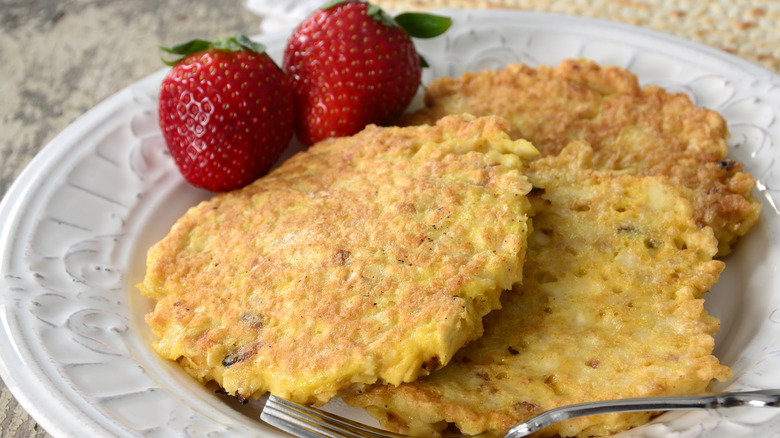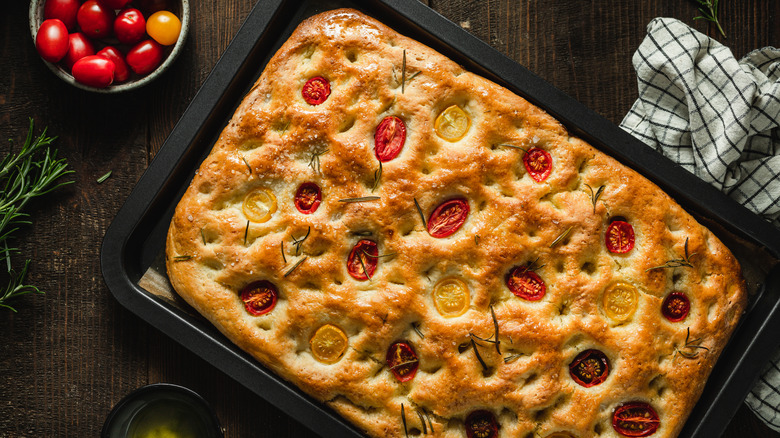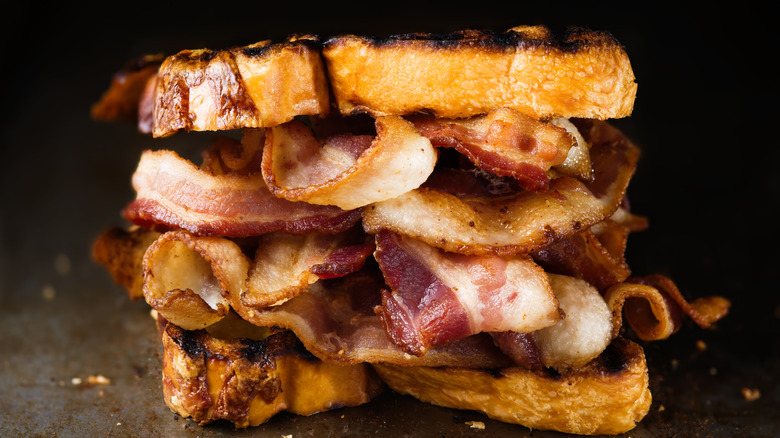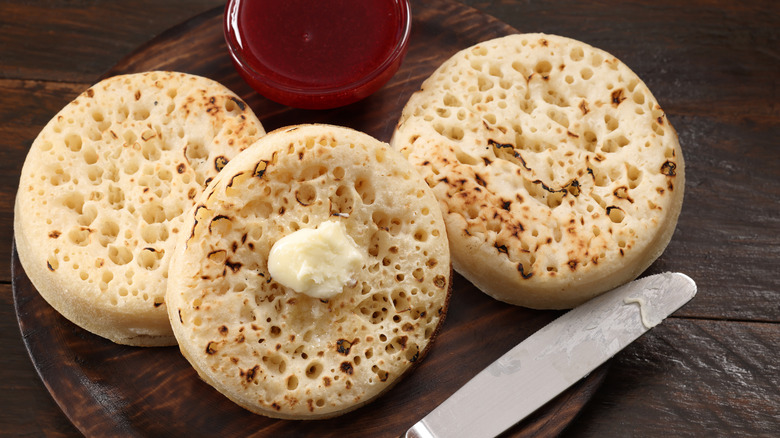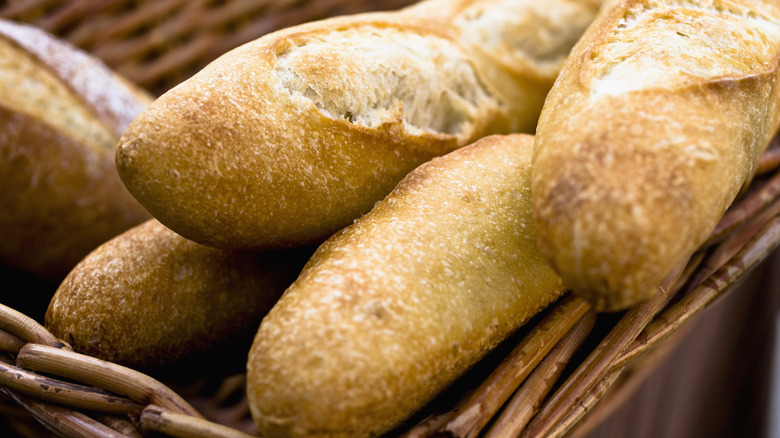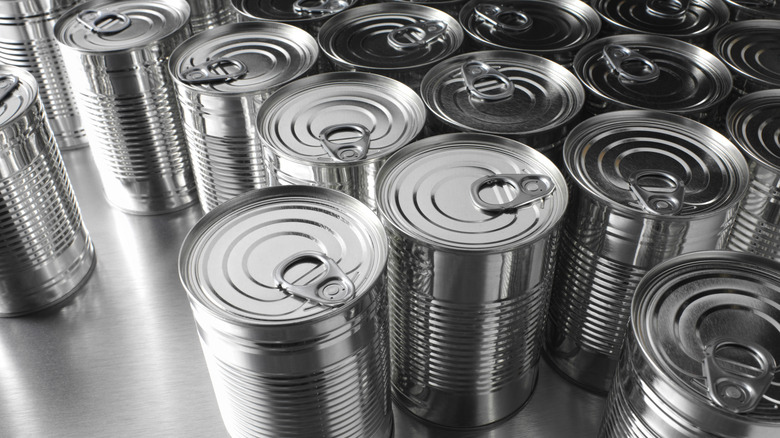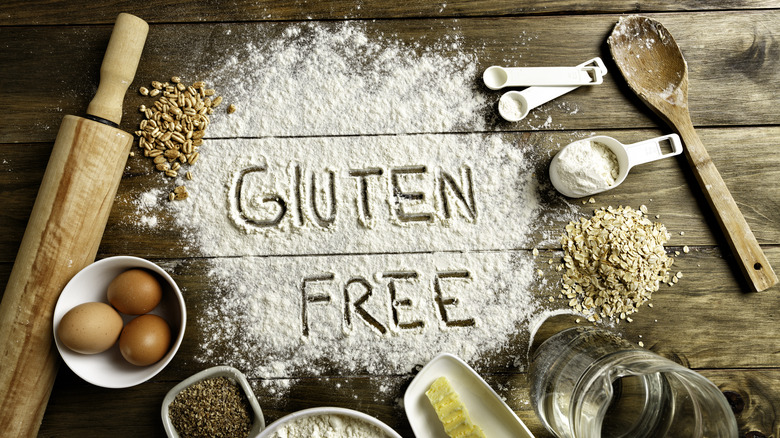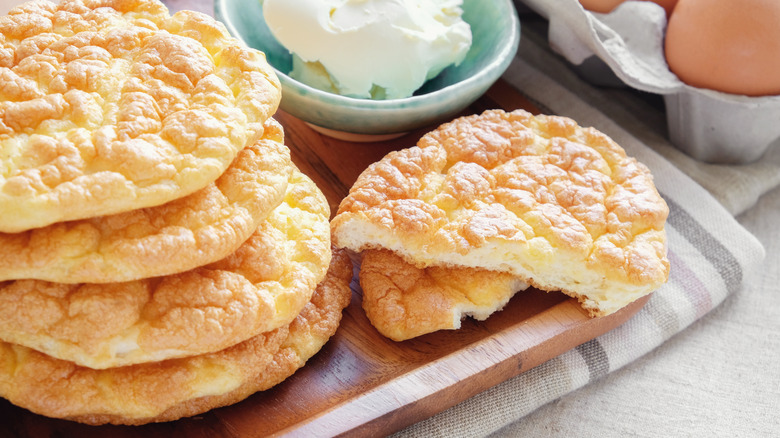11 Breads You Should And 5 You Shouldn't Use For Your Breakfast Sandwich
We may receive a commission on purchases made from links.
Taking the morning meal and making it portable is an issue that has plagued humans for centuries, giving rise to everything from breakfast pasties to Gogurt. But the holy grail of the portable breakfast is undoubtedly the breakfast sandwich. Delicious, filling, and easy to eat on the go, it comes in many forms. While bacon, egg, and cheese is a storied fave, options may run the gamut from sausage to smoked salmon, veggies to avocado.
But fillings are far from the only variety you'll find in this sandwich category. After all, what is a sandwich without bread?
Some regions hold fast to tradition with their breakfast sandwich breads, from the British bap to the New York City bagel. But when it comes to choosing how you're going to render breakfast portable, a panoply of options is available — and some are better than others. A great breakfast sandwich vehicle will provide enough structure without overwhelming the fillings, and it should, of course, be delicious. If you want the ideal breakfast sandwich vehicle, here are the breads, rolls, and other accouterments you should use ... as well as those perhaps best forgotten.
You should use English muffins
English muffins are the bun of choice for that stalwart of fast food breakfast sandwich options: the good old Mickey D's Egg McMuffin, which upon its invention in 1971, cemented its spot as one of the oldest fast food breakfast choices. But it's not just because the McDonald's breakfast sandwich tops public opinion polls that the English muffin deserves its accolades as a breakfast sandwich base to be reckoned with. The shape and size of an English muffin make it the perfect vehicle for a fried egg or small folded omelet and a slice of melty American cheese, and the nooks and crannies that are innate to this little bread are ideal for cradling juices from additions like sausage or bacon as well as your sauce of choice, like ketchup or hot sauce. It's no wonder English muffins are such a breakfast sandwich staple, from fast food chains to restaurants to home kitchens.
You should use a tortilla
Is a quesadilla a sandwich? If so, the TikTok tortilla egg sandwich is too, and it's perhaps one of the more unique choices on this list. If it is, then the TikTok egg sandwich hack is definitely a breakfast sandwich — and a pretty genius one at that. This hack sees the tortilla divided into four quadrants, each of which is filled with a different ingredient. In the case of a breakfast sandwich, this might be avocado, bacon, cheese, and mushrooms. The tortilla is added to a heated, buttered pan atop a layer of beaten eggs, which coat the tortilla as it cooks, making it kind of like a blend between savory French toast and an inside-out breakfast sandwich.
Of course, this isn't the only way you can use a tortilla to make a breakfast sandwich. Simply filling it with your breakfast items of choice — scrambled eggs, cheese, and bacon would make a great combo — and folding it like a taco or rolling it like a burrito makes for a breakfast tortilla perfect to take on the go.
You should use a bagel
A bagel is the bread of choice for a New York City BEC (bacon, egg, and cheese), and for good reason. With sturdy heft and chew, a bagel won't go as soggy as a roll, and seeing as most New York City bagels weigh about six ounces — three times more than two slices of standard bread — this behemoth of a breakfast sambo is sure to keep you full well into the afternoon.
There's no shortage of New York City bagel spots attempting to perfect this staple, with bagel shops and restaurants offering anything from farm-to-table bacon options to a BEC that gilds the lily by adding a latke to the mix. And while it's been replicated by fast food spots like McDonald's, if you can't get to New York, you might be better off making your own, either with a high-quality bagel from a local shop or, if you're feeling fancy, with a homemade bagel.
You should use a biscuit
For a rich, buttery breakfast sandwich, there's perhaps no base better than a biscuit. This fluffy, flaky favorite of fast food purveyors like Burger King stands up wonderfully to a pile of fillings, and unlike simpler breads, the biscuit definitely doesn't fade into the background.
Frozen biscuit breakfast sandwiches are a star product of companies like Jimmy Dean, which make these sandwiches easy to grab, zap, and go. And while some folks find them messier than other breakfast sandwiches, following the advice of experienced biscuit sambo experts, like one Amazon reviewer who offered the helpful advice to leave these breakfast sandwiches in the original wrapping when microwaving rather than wrapping in a paper towel, will ensure you have the ideal experience. But if you want to one-up on frozen (and you're feeling particularly industrious), a homemade biscuit breakfast sandwich really knocks it out of the park.
You should use a kaiser roll
A Kaiser roll is an ostensibly Viennese creation, so named for its crown-like shape. It has since been adopted — with myriad monikers — throughout the U.S, nut whether you call it a hard roll or a bulkie, this bread is the ideal base for a breakfast sandwich.
Kaiser rolls boast a phenomenal texture for sandwiches: puffy and soft on the inside and with a crisp, caramelized crust, they support fillings without overwhelming them with too much flavor or heft. While frequently found plain, some kaiser rolls may be sprinkled with flax or sesame seeds, lending even more flavor and texture to the finished sandwich. Making kaiser rolls at home can be a bit of a faff, with a unique folding method that takes a bit of getting used to, but you can easily track these fluffy rolls down at bakeries, delis, and even your local Sam's Club, where the rolls, according to one reviewer, have "a wonderfully crisp, not quite crunchy, dark tan crust and a light, pillowy interior."
You should use a bap
If you're living Stateside, you may have never heard of the beautiful, floury bread roll the Brits know as a bap — and what a shame indeed. A soft white bun often made with milk, lard, and butter as per Serious Eats, which terms the bap "a more humble, Scottish version of the brioche."
Somewhat confusingly, a bap goes by many names ranging from bap to barm to cob. Some research even claims that there may be seven different words just for this type of roll throughout the UK. And even more confusingly, the word "bap" can refer both to the roll and to the sandwich assembled therein, as in this "breakfast bap" offering from the BBC featuring pork sausages, bacon, eggs, beans, and chips (aka fries) for what could also be seen as a full English to go. A light repast it is not, but it's certainly a good option for the morning after the pub!
You should use brioche
Brioche is an enriched bread originally hailing from France. Made with eggs, butter, and a touch of sugar, this bread has recently become a top contender as a stand-in for burger buns and a base for breakfast sandwiches, dotting the menus of restaurants seeking to lend their sambos that je ne sais quoi. And while some critics claim brioche is too sweet for sandwiches, the right recipe will dial down the sugar just enough for the ideal sweet-and-savory base for a filling of salty cured meat, cheese, and egg.
The richness of brioche makes it the perfect option to stand up to slightly more assertive fillings, like flavorful muenster cheese, garlic-scented aioli, or peppery arugula, as at San Francisco's The Bandit. Consider other combos too, like pepper-crusted bacon or spicy sausage patties. Particularly lovely on a special occasion, brioche is the ideal breakfast sandwich roll for Sunday brunch — gild the lily by griddling it in butter for a real treat.
You should use a croissant
As long as you're opting for a buttery base for your breakfast sandwich, why not opt for that flaky marvel of French baking, the croissant? Made by layering blocks of butter between slabs of butter-based dough in a process known as lamination, croissant dough contains 55 layers of buttery bliss, forming a breakfast sandwich base that's rich and tender on the inside and irresistibly crispy without.
Croissants form the base of many a fast food breakfast sandwich, and honestly, it's hard to fault these options. They're filling and flavorful, plus they're super easy to grab and go. That said, if you want even more crispiness and flavor, why not make your very own copycat Croissan'Wich? This recipe doesn't just allow you to trade up the industrial fillings typically used at fast food joints in favor of top-quality cage-free eggs or nitrite-free bacon, but if you're feeling particularly industrious, you could even try your hand at making your very own homemade croissants, rocketing your 'wich to gourmet status.
You should use pancakes
If you're a lover of sweet-and-savory combinations, there may be no better breakfast sandwich base than pancakes. This creation made famous by the McGriddle has inspired everything from a creation by Hot Pockets to a "pancake burger" at Red Apron in D.C. And in crafting the McDonald's staple sandwich at home, LifeHacker explains, you can control the flavor, texture, and, perhaps most essentially, the height of the pancakes, further contributing to the superiority of this choice.
Of course, if you're making a pancake breakfast sandwich at home, your pancake-making steps will be a bit different. Notably, LifeHacker explains, you'll want to consider the amount of sugar you put in the pancakes and how it will interact with the other fillings. And above all, it's essential to let the pancakes rest on a grill while you fry the eggs for the filling, lest they become soggy while they wait.
You should use matzo brei
Matzo brei, for the Goyim among us, is a Passover classic hinging on its use of leftover unleavened matzo. The crispy bread is saved from a sad, stale fate by being mixed with eggs and fried to make something halfway between a scramble and French toast, Ksenia Prints writes in her matzo brei recipe.
For Danielle Oron of I Will Not Eat Oysters, matzo brei patties, which she dubs boomwellohs, are used as the base of a breakfast sandwich filled with eggs, ricotta, and garlic-scented kale. But once you've mastered this technique, there's no reason you couldn't use matzo brei as the base of other breakfast sandwiches, from simple avocado to egg and cheese. You can even season the egg mixture to add even more flavor to your breakfast sandwich. A bit of Everything But the Bagel Seasoning would pair particularly well with a smoked salmon filling.
You should use focaccia
Moist, chewy focaccia is delicious all on its own, but it's also a wonderful breakfast sandwich base option for those on the lookout for something even richer than a biscuit. This doughy Italian flatbread is generously flavored with olive oil and may even be topped with herbs, vegetables, olives, and more, making it a particularly fun base to play with when crafting the optimal symphony of breakfast sambo flavors. And if you're making focaccia at home, you can even mess with the classic to your advantage. Caramelized onions could be nice paired with bacon and Swiss cheese. Cherry tomato and dried herb focaccia might be fun to pair with an Italian sausage and a bit of mozzarella cheese for Italian flair.
However you top it, the most important thing to consider when using focaccia as a breakfast sandwich base is how you slice it. Since focaccia tends to be quite thick and crusty, split each thick slice in half, so that the doughy center is up against the fillings.
You should use white bread
Humble white sandwich bread is a go-to for lunchtime sandwiches, but it should be just as welcome on the breakfast table — so let's start that trend here and now!
Get inspired by the breakfast butty, a British classic made by smearing butter on bread (thus the name). Butties can be filled with anything from chips to bacon, and it's the latter that's currently vying for a spot as the breakfast sandwich of record. A bacon butty is easy to prepare, with just four ingredients — bacon, butter, ketchup, and white bread. Once toasted, the bread becomes the ideal no-nonsense option that serves as a conveyance for fillings without overwhelming their flavors.
Of course, if bacon feels like too simple a filling, you're more than welcome to mess with the classic. American cheese would be a welcome addition, as would a fried egg. Consider adding some HP sauce to retain that British flair. The only thing you must do to ensure this sandwich stands up to your expectations? Toast that bread well. Untoasted white bread would likely become soggy too quickly to make it a convenient or delicious breakfast sandwich option.
You shouldn't use crumpets
While crumpets may seem to the uninitiated to be quite similar to English muffins, the truth is that their Britishness (and the presence of holes) are the two only commonalities shared by these breads. An English muffin makes a wonderful breakfast sandwich bread by virtue of its splittability. A crumpet, relatively towering at over an inch in height, should not be split, and two stacked on top of one another would result in a breakfast sandwich you'd need to be a snake to get your jaws around. Even The Guardian dubs crumpets "too stodgy" for breakfast.
Of course, if you accept that a sandwich need not be portable or closed to be enjoyed, a crumpet could serve as a pleasant base for some of the same fillings, positioned instead as toppings. But is this a sandwich or a benedict? Such conversations are far too philosophical for the morning, so best leave sandwiching to other rolls and enjoy crumpets as god intended: topped with butter and Marmite.
You shouldn't use baguette
Baguettes make wonderful conveyances for more demure sandwiches like the Parisian ham-and-butter classic, or even certain softer fillings like tuna salad. But a breakfast sandwich is meant to be consequential; bacon, egg, and cheese demand something that won't collapse under the pressure.
Baguettes, of course, are sturdy, and that's the problem: The issue with baguettes as a breakfast sandwich vehicle isn't one of tastiness but one of texture. Crisp and chewy, a baguette is too hard to sink your teeth into without risking sending the bacon, egg, and cheese splurting out the other side of the sandwich. You could try to force your bacon egg and cheese into the baguette with a Stuffastick, but given how many tasty options there are for breakfast sandwich conveyances, it might be better to let the baguette do what it does best and choose another roll for your breakfast sambo.
You shouldn't use canned bread
A Colonial invention, canned bread does what it says on the box — er, can. Kind of. A steamed creation stemming from times of scarcity, canned bread is dense and somewhat jiggly, rendered sweet with molasses. While many do find it tasty (and many, it must be said, do not), this cake-like creation does not a great sandwich bread make. It really requires a fork and knife to eat it, and is thus usually served on a plate, topped with things like baked beans, chopped hot dogs, or simply spread with bread and butter. If you really wanted to, there's no reason you couldn't plate up some brown bread with bacon, eggs, and cheese, but not only are we veering sharply out of sandwich territory, given the fact that many compare canned bread's flavor and texture to that of banana bread, this seems like it would be a fairly odd choice.
You shouldn't use low-quality gluten-free bread
You really shouldn't be using bad bread to make any sandwich — though, as Serious Eats rightly points out, you can certainly mask some bad qualities of sandwich bread by either toasting it or griddling it (preferably in butter). But bad gluten-free bread is an even worse offender.
Gluten is the protein that allows bread to have its chewy, delectable structure. So when you attempt to make bread without it, you need to resort on all manner of gums and additives. Some brands do this very well, but many low-quality gluten-free breads range in texture from gummy to crumbly, neither of which is a particularly sought-after texture in any bread, particularly one that's meant to support sandwich fillings. And to add insult to injury, many of these breads suffer in the flavor department too. Seek out well-reviewed gluten-free bread brands to ensure that just because you're not eating gluten doesn't mean you're not enjoying your breakfast sandwich.
You shouldn't use cloud bread
Is cloud bread really bread? Technically, this pillowy concoction of eggs, cream cheese, and cream of tartar isn't bread at all, but the gluten-free, protein-rich alternative purports to be the ideal paleo-friendly substitute for bread on a breakfast sandwich.
Cloud bread has a few things going for it. For one, it's easy to make Simply whip the egg whites and cream of tartar until soft and fluffy, then fold in the egg yolks and cream cheese and bake. Does it work? Yes. Is it delicious? Not according to Epicurious' food director Rhoda Boone, who says that cloud bread is "a little worse than a rice cake.
In short, cloud bread can be used as a base for a breakfast sandwich, but just because you can doesn't mean you should. If you're on a low-carb or gluten-free diet and are really jonesing for a BEC, go for it. If not, stick to real bread.
